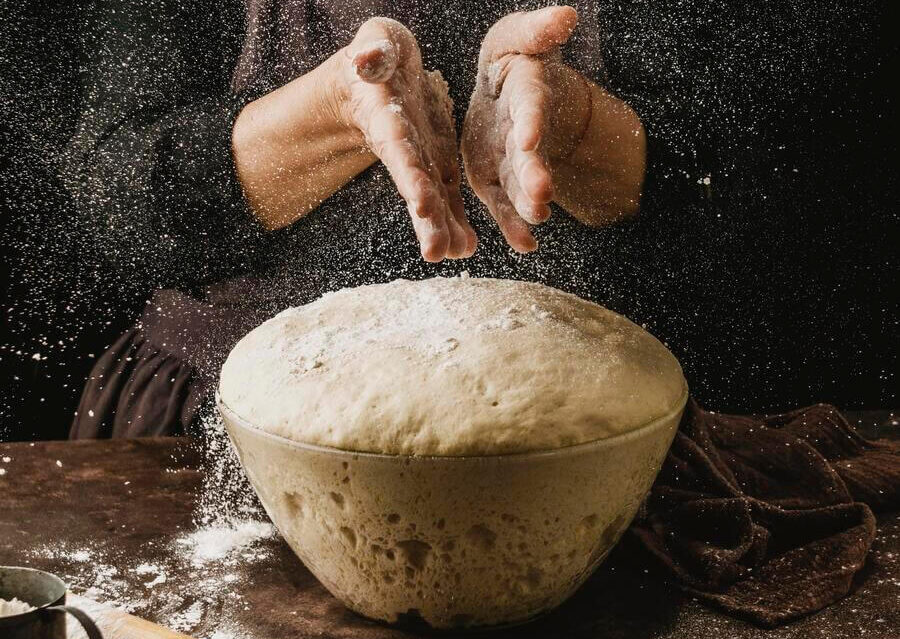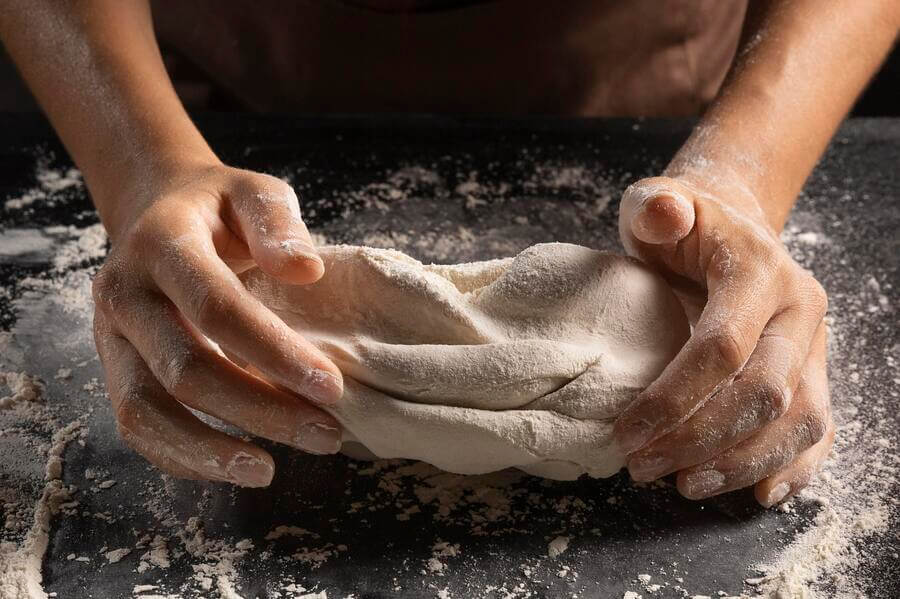Making the perfect pasta dough can be a daunting task, especially for beginners. And one question most pasta makers ask is whether you can over-knead a pasta dough.

The simple answer is yes. It is not uncommon for people to over-knead the dough due to using the wrong flour, incorrect machine settings, or excessive force.
Fortunately, you can rework an over-kneaded dough into its perfect texture. This article examines what leads to over-kneading, how to identify over-kneaded dough, and how to prevent it. Let’s get into it.
What Can Lead To Over-Kneading Pasta Dough?
Here are some of the most common mistakes that lead to over-kneading pasta dough.
Using Excessive Force
Using excessive force when kneading can lead to overworking the pasta dough. It causes the gluten to become tight and tough. As such, you get an end product that is difficult to form into small oval shapes. Use the proper pressure to develop the gluten while maintaining elasticity and a smooth texture.
Kneading For An Extended Period
Another reason you get over-kneaded pasta dough is working on it for too long. Most novice pasta makers make the mistake of kneading for over 10 minutes, thinking that the longer they work on it, the better the texture.
However, this is far from the truth. You should knead the dough for at least 10 minutes.
Using The Wrong Flour
Besides using excessive force and kneading for too long, using the wrong flour can lead to over-kneading. Ideally, you should use all-purpose, 00, or semolina flour, depending on the type of pasta you are making.
So, if you aim to make soft pasta but use high-protein flour, you are more likely to over-knead the dough.
Using A Pasta Making Machine
While using a pasta-making machine saves time, it can also lead to over-kneading if you don’t monitor it. Your electric machine may run at a high speed, causing it to work on the dough longer than you would with your hands.
To mitigate this, set its pace to medium or low and feel the dough’s texture every few minutes.
What Are The Signs Of Over-Kneaded Dough?
How can you tell you have over-kneaded your pasta dough? Let’s find out.
The Dough Becomes Tough
As you’d expect, the over-kneaded dough is tough. Overworking the dough causes the breakdown of gluten proteins, which give it a smooth and elastic structure.
Generally, as you stretch and fold the dough, you facilitate the formation of strong bonds. Unfortunately, over-kneading destroys the bonds, causing the dough to become challenging.

The Dough Becomes Inelastic
As mentioned, kneading facilitates the formation of bonds between gluten proteins, leading to elasticity. However, if you over-knead the dough, you destroy these bonds.
As such, it loses its elasticity, causing the dough to become stiff. It means you’ll find it daunting to roll it into shape since it does not stretch.
The Dough Has A Dull Color
Besides the texture and feel of the dough, you can tell if you’ve over-kneaded by its color. Once you over-knead it, the gluten proteins become damaged, leading to oxidation. Oxidized gluten proteins are less elastic, causing the dough to appear gray or dull.
In addition, breaking down of starch granules can cause it to appear dull. Like gluten proteins, the granules are thoroughly broken down, making a sticky dough that is hard to work with.
And since over-kneading causes the dough to become dehydrated, you can expect it to change to a gray color.
Uneven Cooking
Another sign for an over-kneaded pasta dough is uneven cooking. It is because the gluten proteins are tightly bound together, making the dough less porous and unable to absorb ample water.
The gluten proteins are resistant to water absorption, may form bubbles, and are likely to break down. As a result, some parts of the pasta may cook slowly or quickly.
What To Do When You Over-Knead Pasta Dough
What steps can you take after over-kneading your dough? Let’s find out.
Let It Rest
Once you establish that your dough is over-kneaded, let it rest for at least 30 minutes. It can help relax the gluten proteins, allowing them to repair the damaged bonds. Remember to cover the dough with a wet kitchen cloth. Otherwise, it will become dry.
Add Water
If the pasta dough is dry, add more water to make it pliable. If the dough is not extremely dry, you can wet your hands and knead gently. Otherwise, you’ll need to add at least a spoonful of water, depending on the size of the dough. After this, you can knead it gently and let it rest.
Knead It Again
Once you’ve let the pasta dough rest, you can knead it again to redistribute the gluten proteins. It is recommended to let the dough rest for long. Typically, pasta dough should rest for 30 minutes. An over-kneaded dough should rest for at least one hour for best results.
Roll It Into Thin Sheets
Since over-kneaded dough can be fragile, it is essential to roll it into thin sheets. They should, however, be relatively thick since they will crack or break easily.
With such texture, the pasta will cook evenly, increase the surface area to absorb seasoning, and allow you to create different shapes and sizes.

How To Prevent Over-Kneading Pasta Dough
Here are a few tips to help you make the perfect pasta dough.
Knead Until It Is Smooth
The perfect pasta dough has an elastic and smooth texture, which should be your goal. Fortunately, you can tell if you have under or over-kneaded by the feel of your hands. Keep adding water and flour until you achieve this texture.
Knead For 10 Minutes
If using your hands, you should need the pasta dough for 10 minutes. This is the recommended time within which gluten develops. Kneading beyond this will destroy the gluten protein bonds, causing it to become dry.
Use A Pasta Machine
While kneading the dough with your hands is an ideal pasta-making process, a pasta machine can be a perfect option, especially if you are a beginner. It would help if you used low to medium speed while checking the dough’s consistency every three minutes.
Final Thoughts
As you can see, over-kneading pasta dough is possible. However, it is easy to tell if you are over-kneading since you can refer to the texture of the dough by hand. Some signs of over-kneading include the dough becoming rigid and stiff. In addition, it becomes dull, and the pasta cooks unevenly.
Fortunately, you can let it rest for an extended period, add water or oil if it is dry, and knead it again to achieve an elastic texture.
Remember to knead the dough for 10 minutes if using your hands and seven minutes if using a standard pasta machine.
